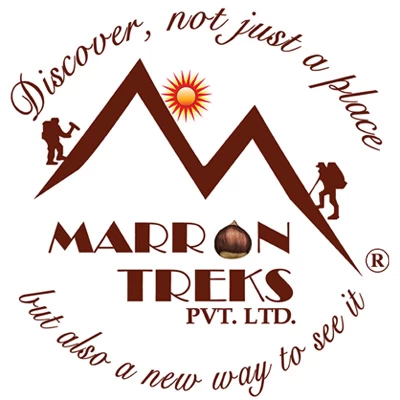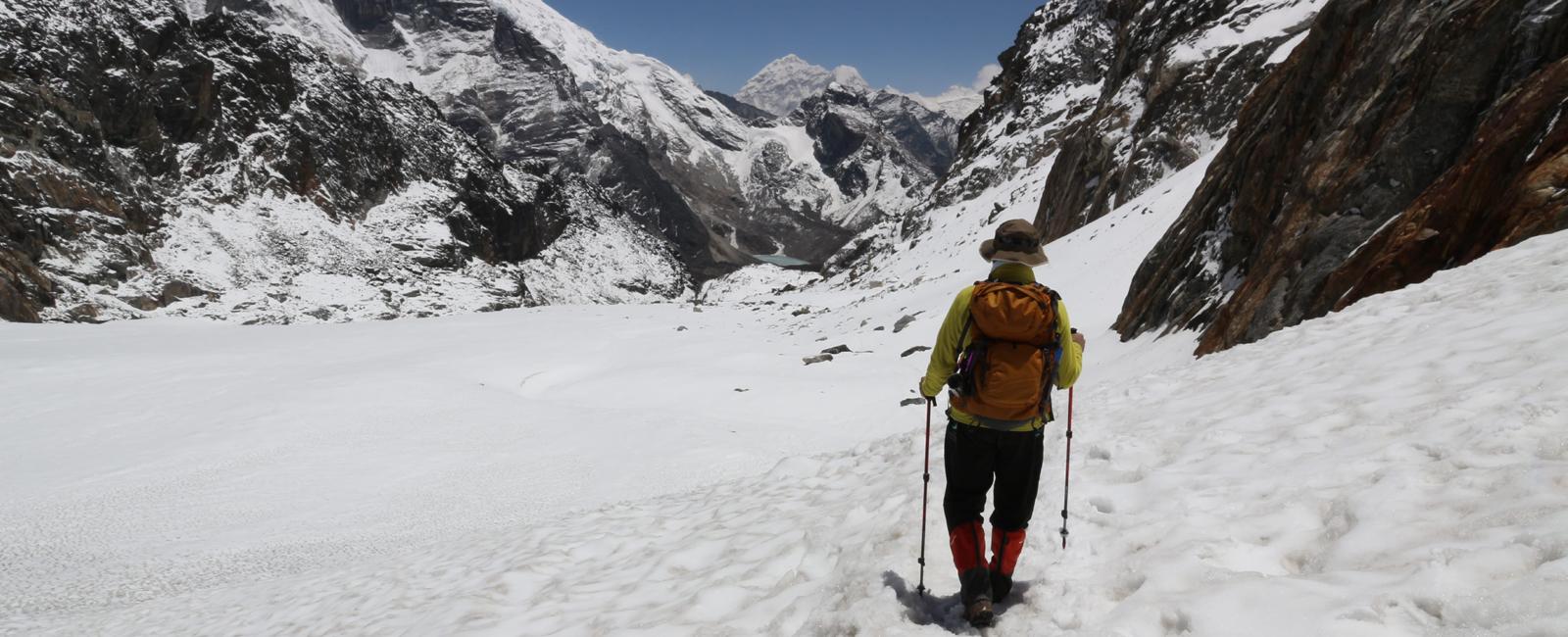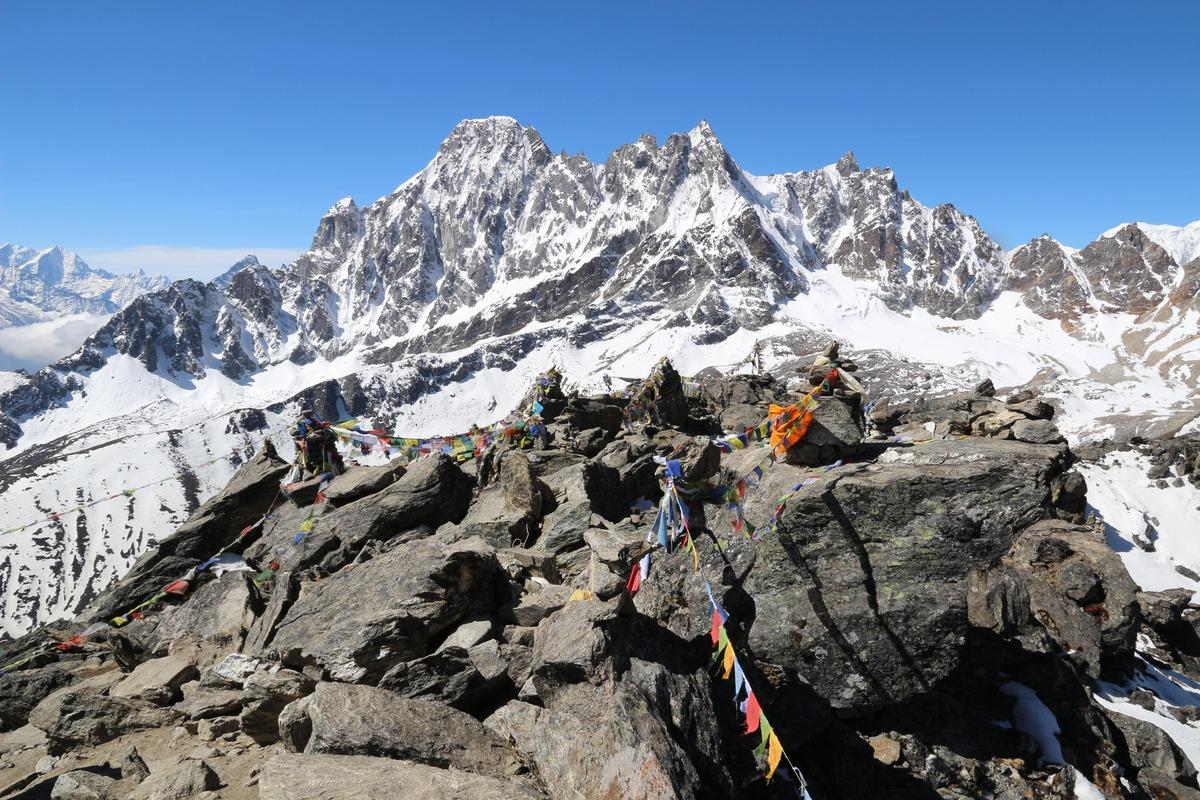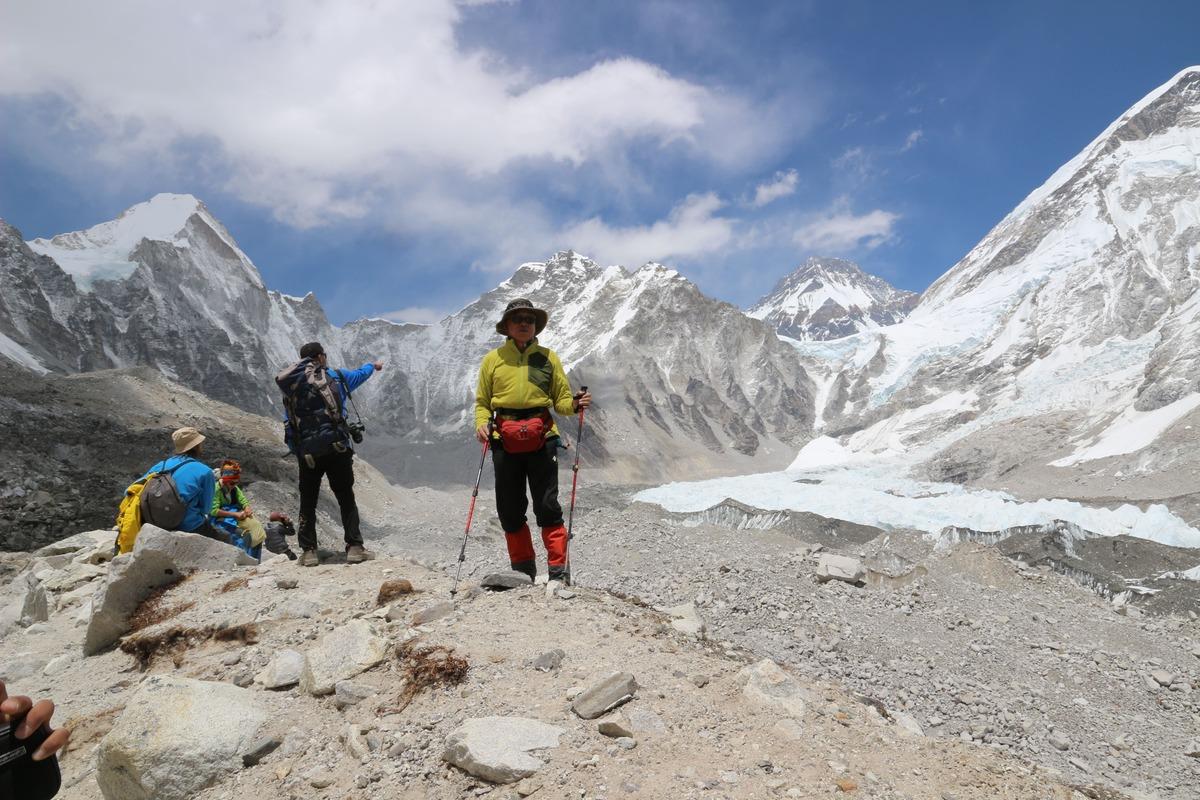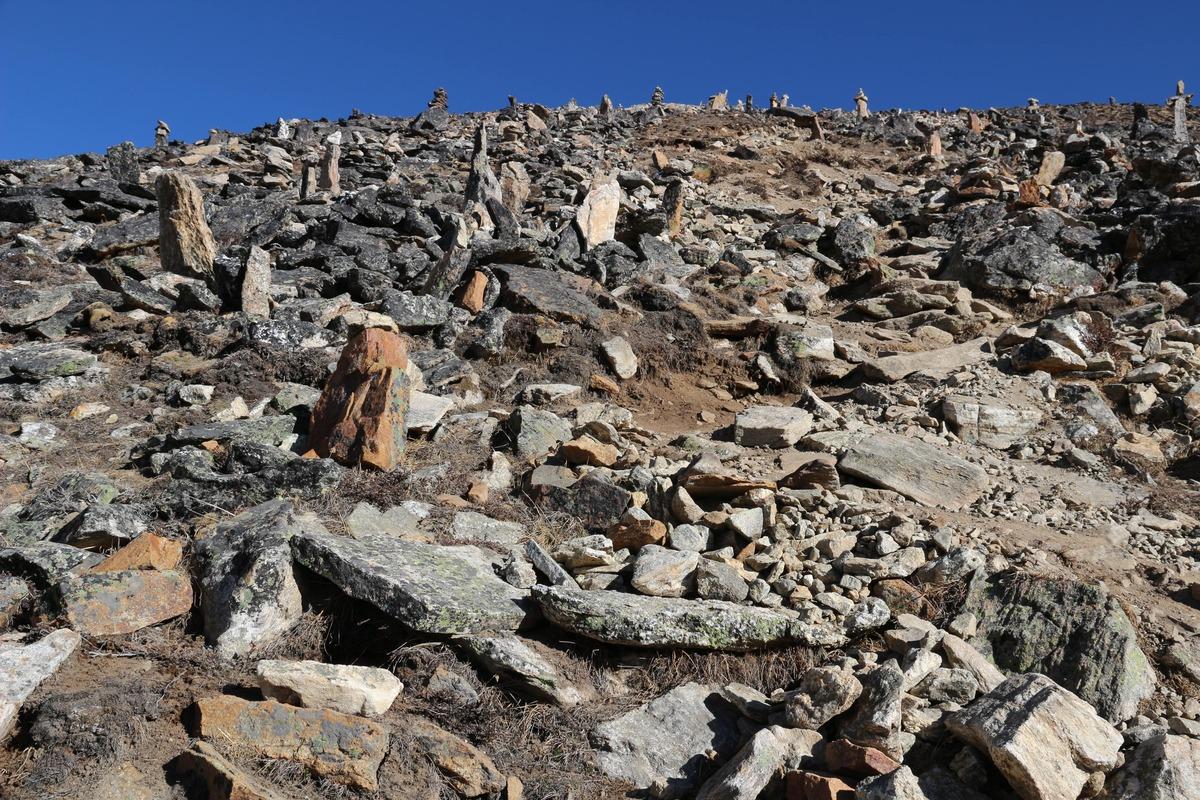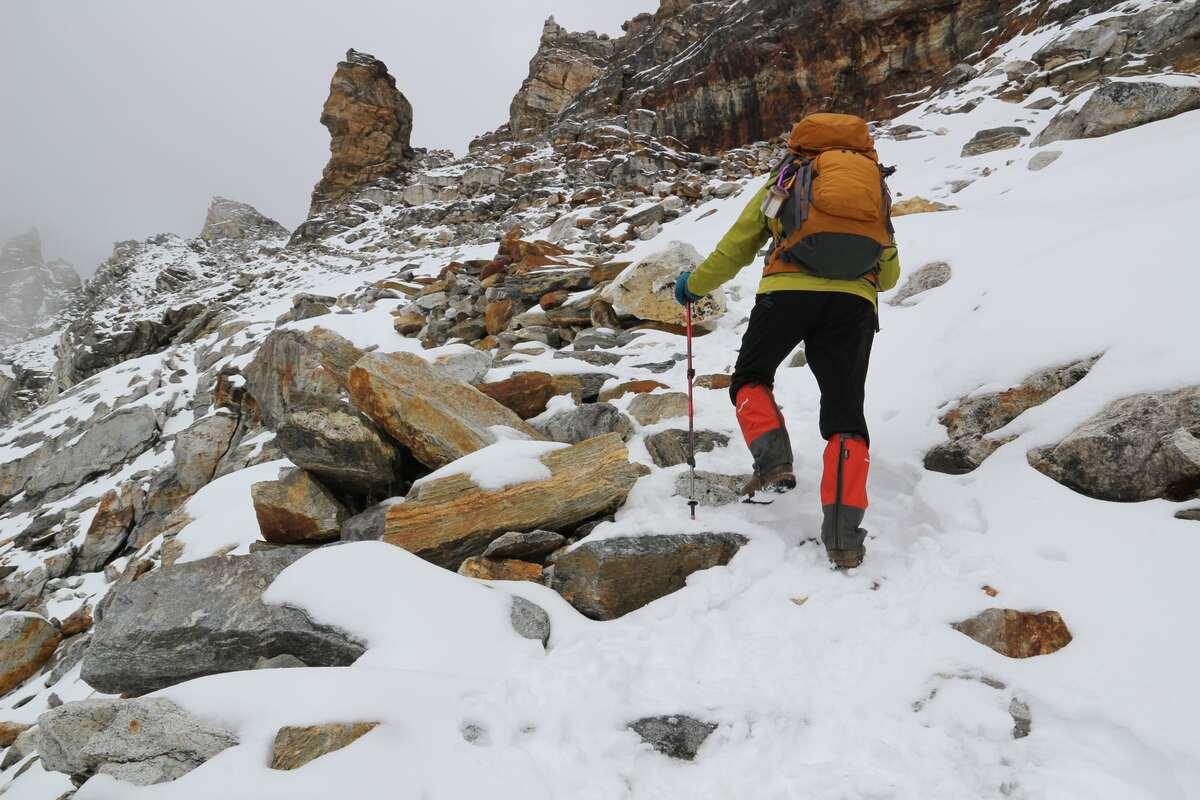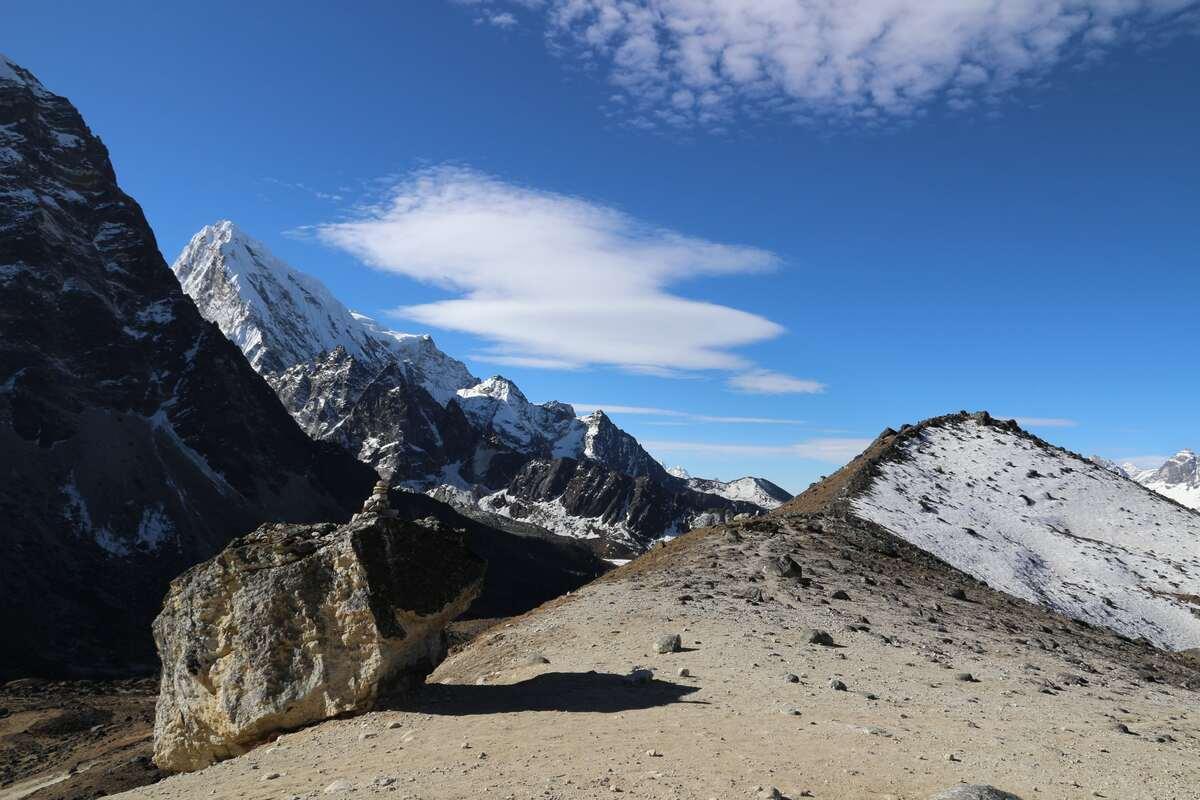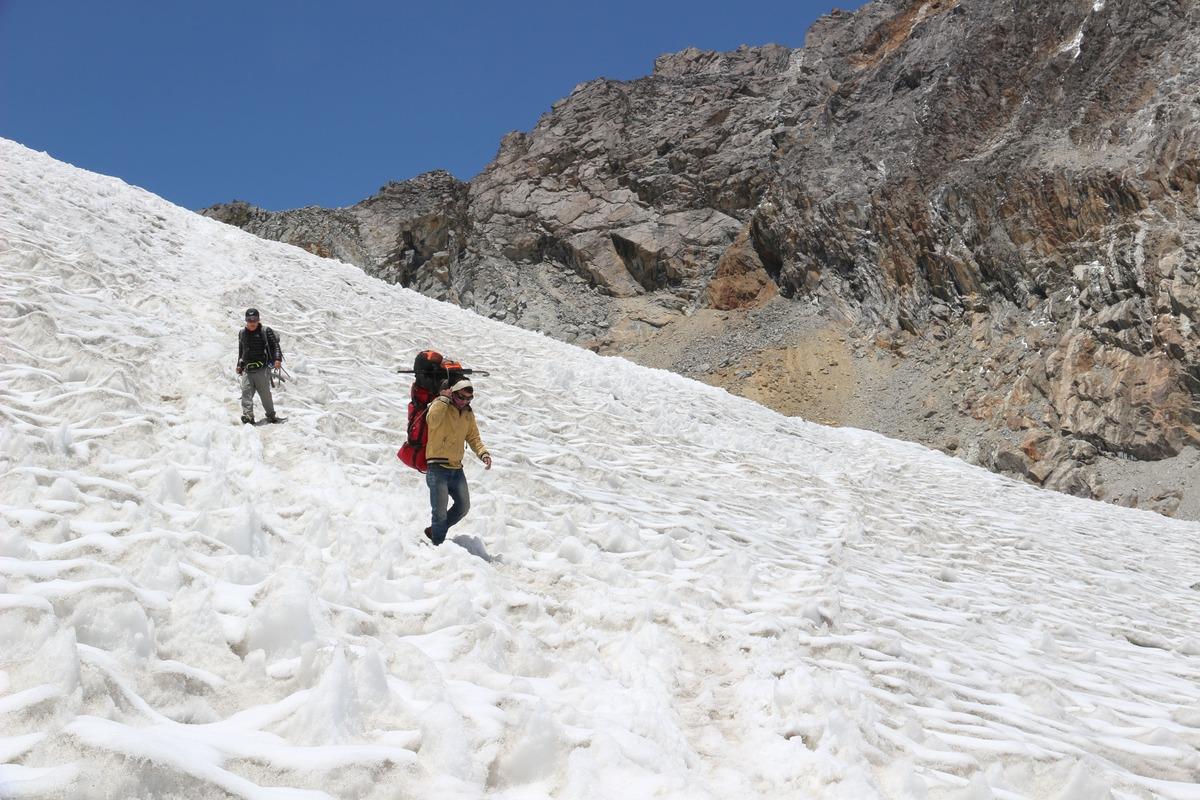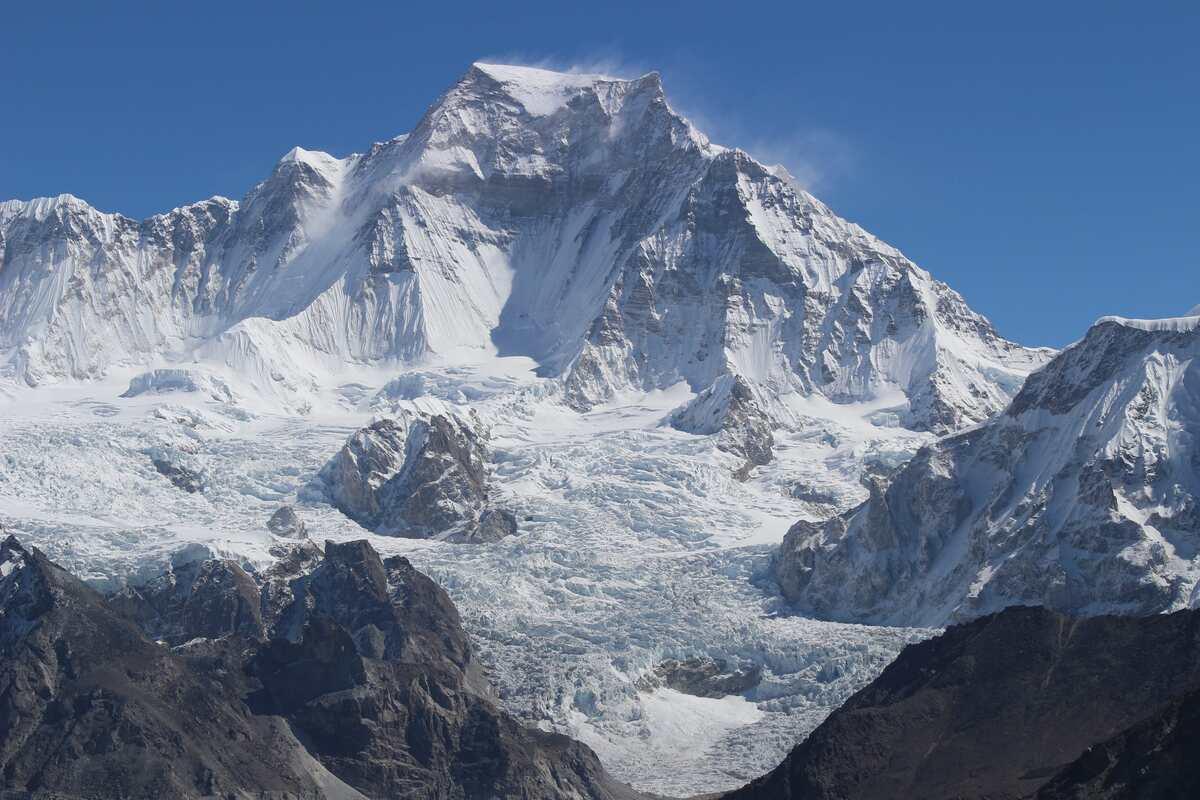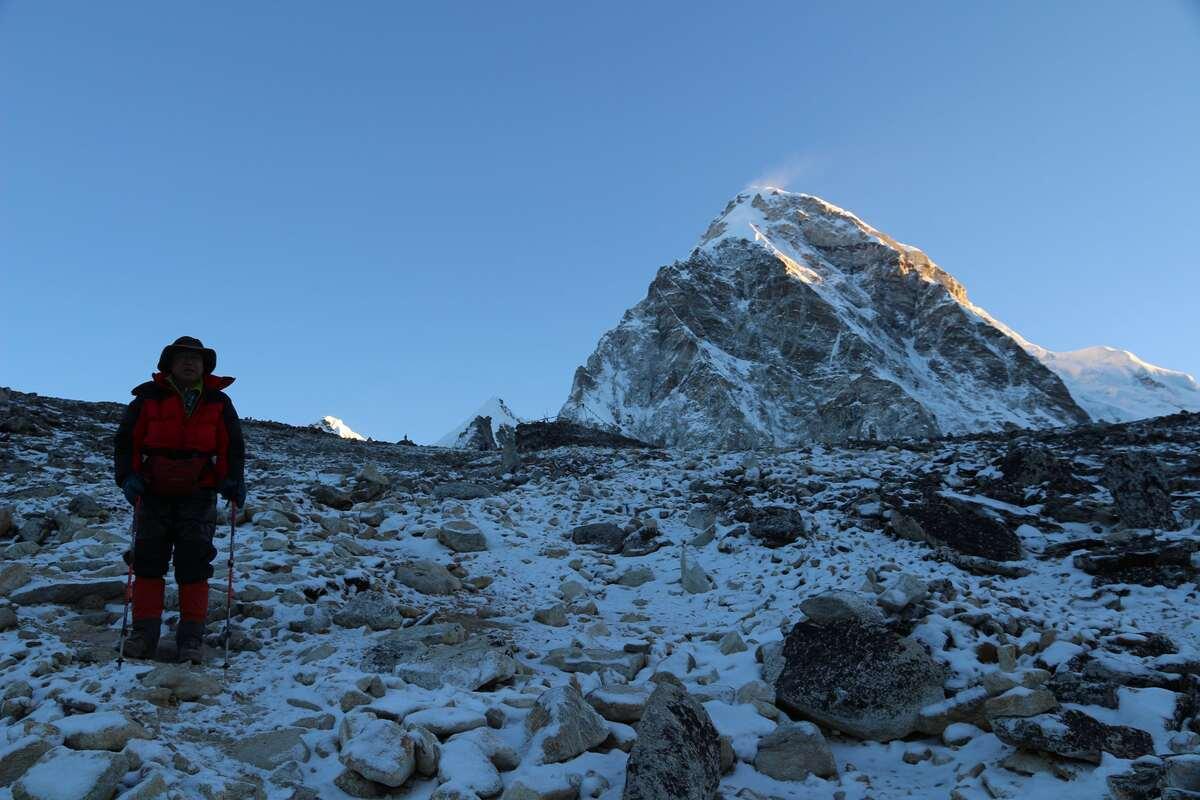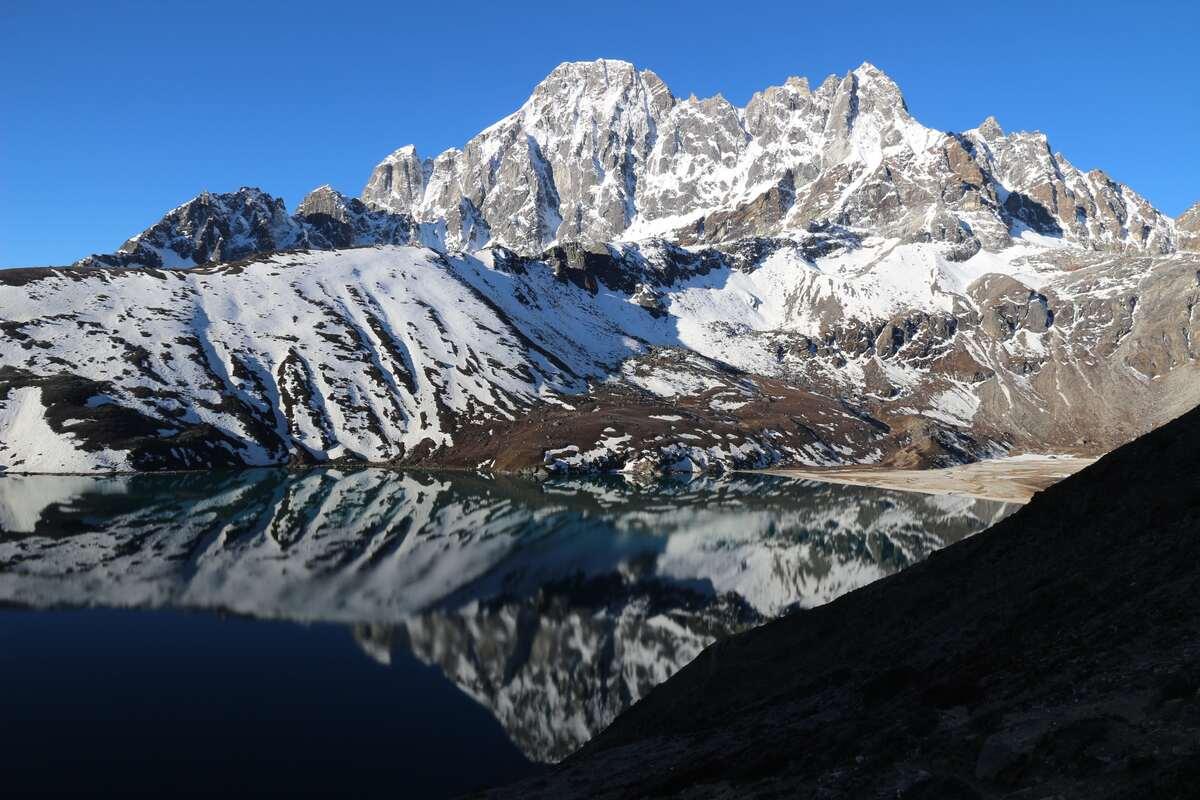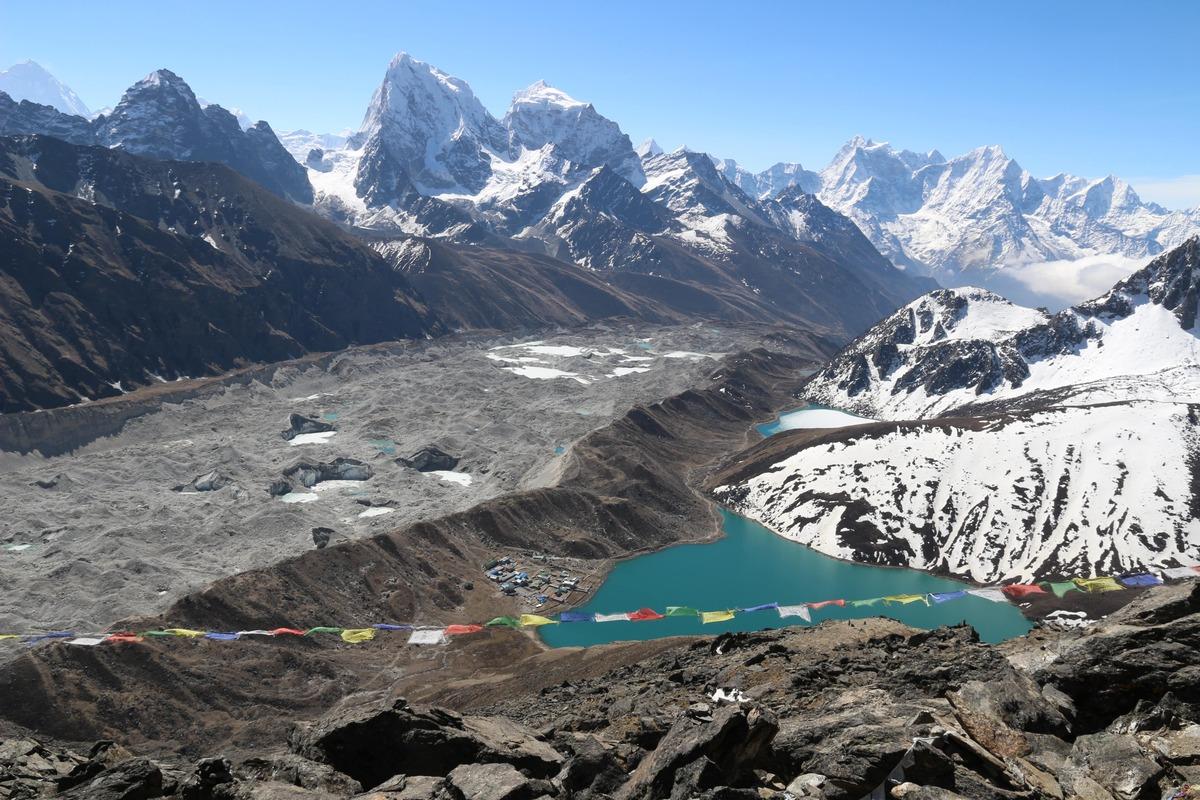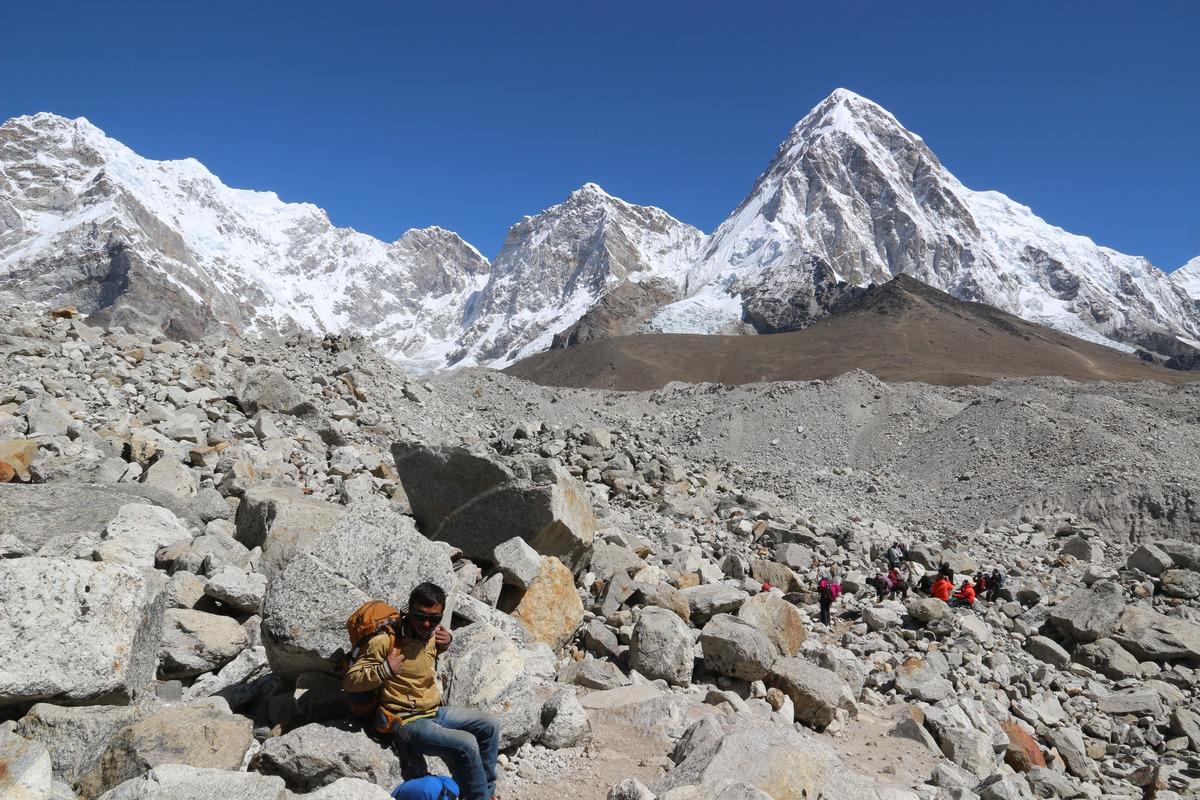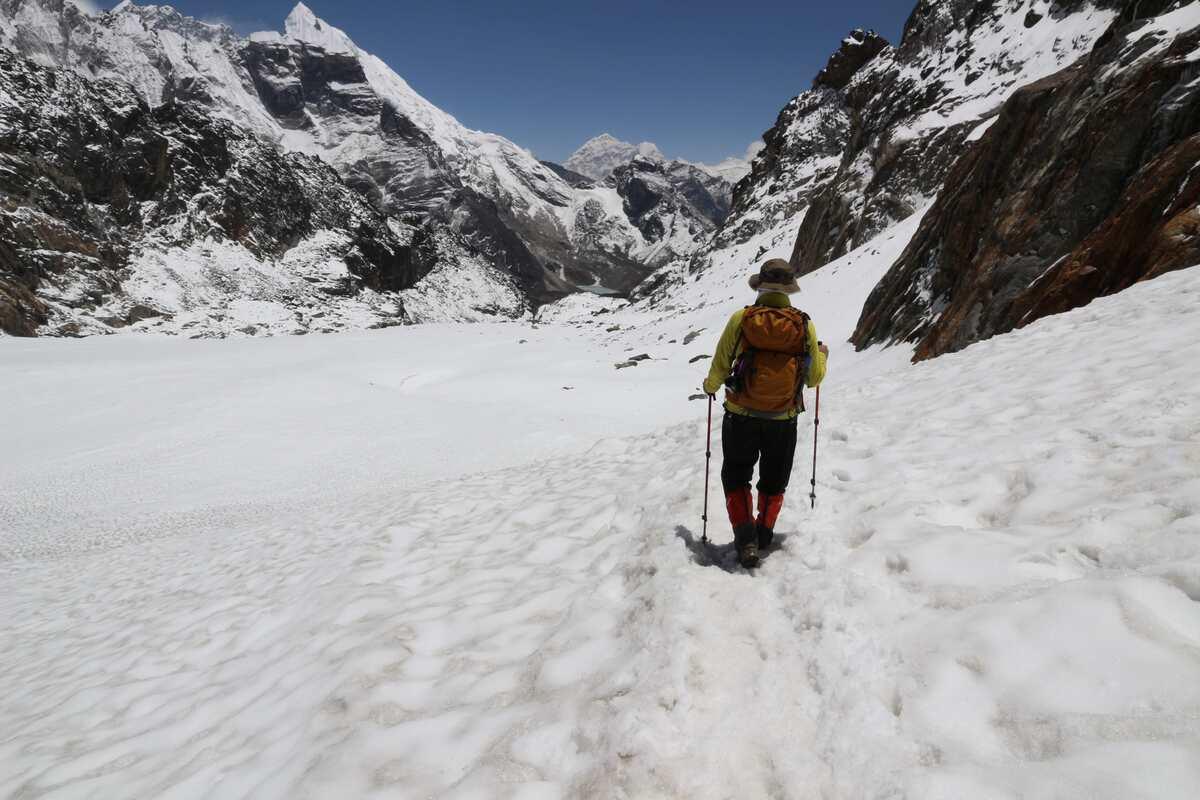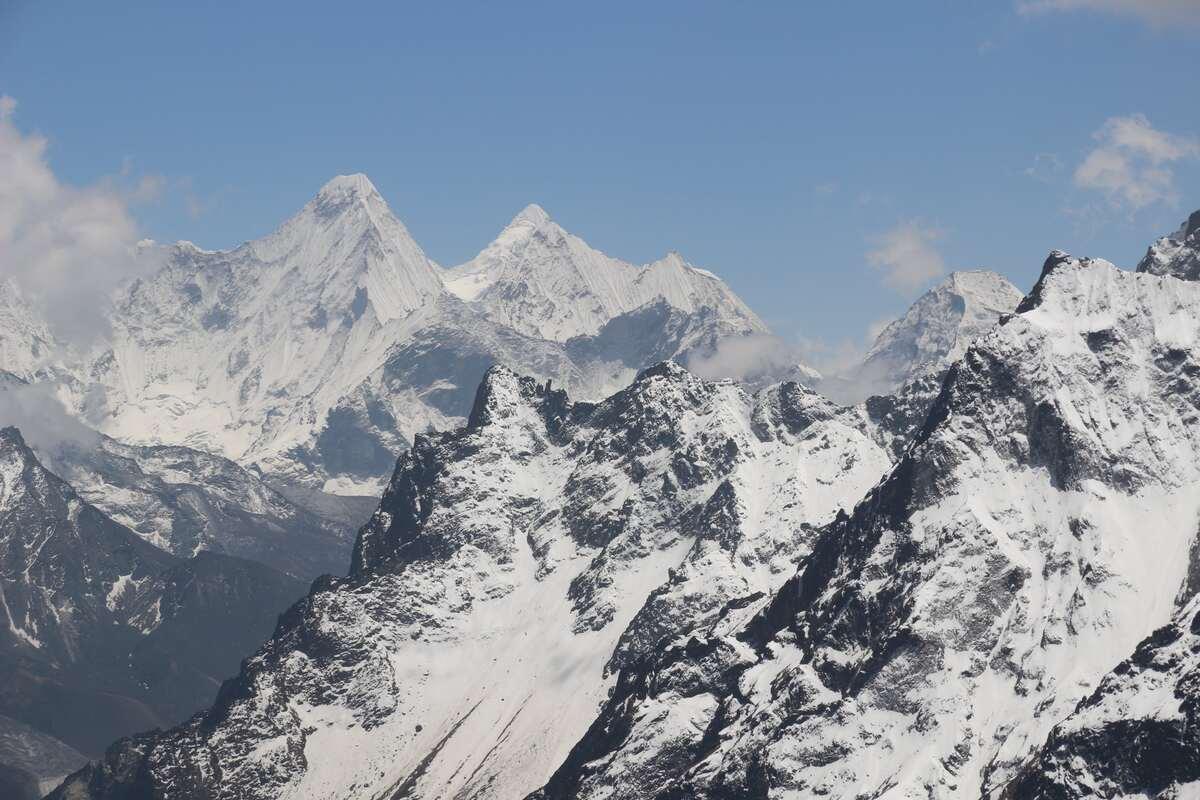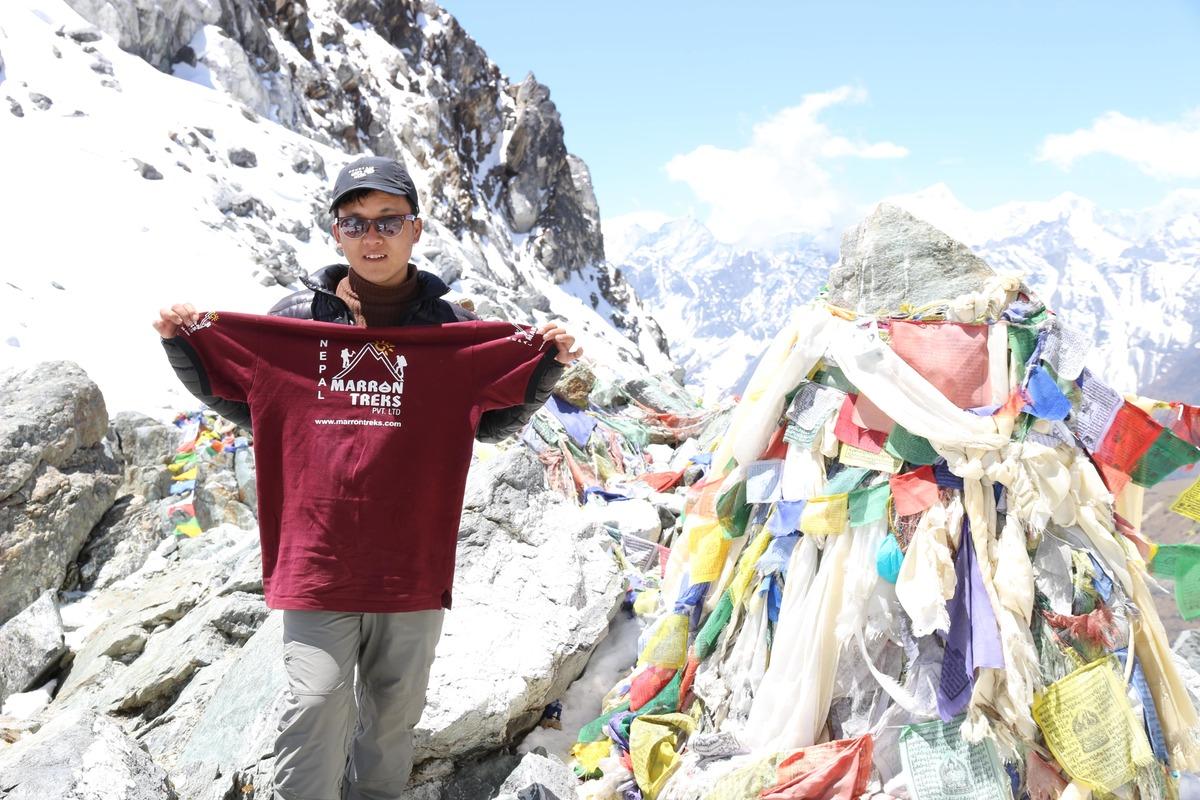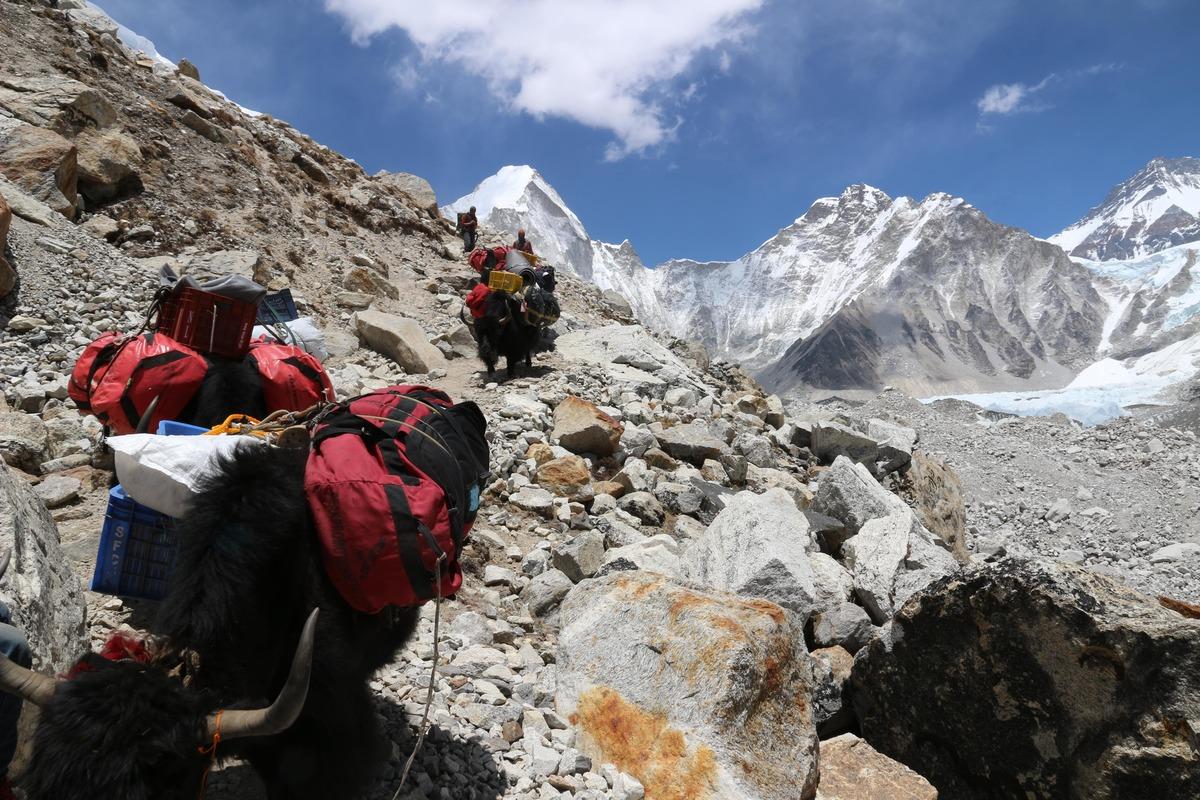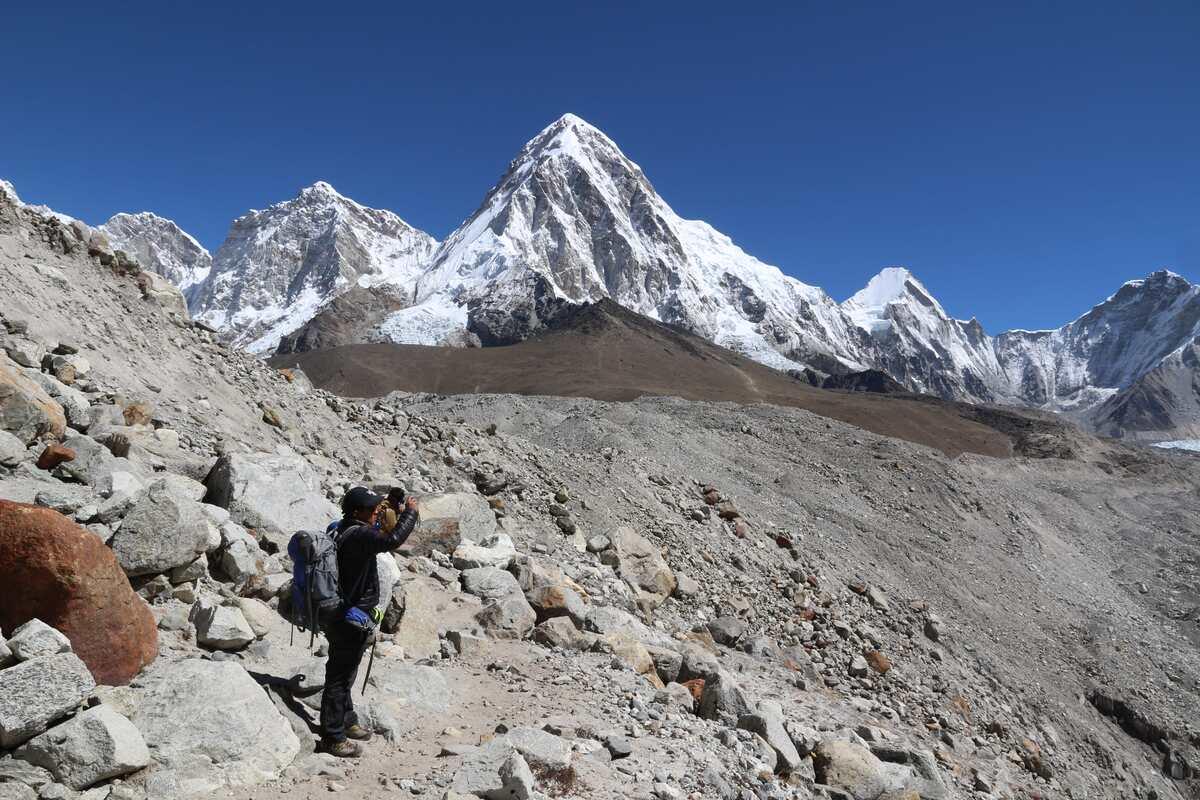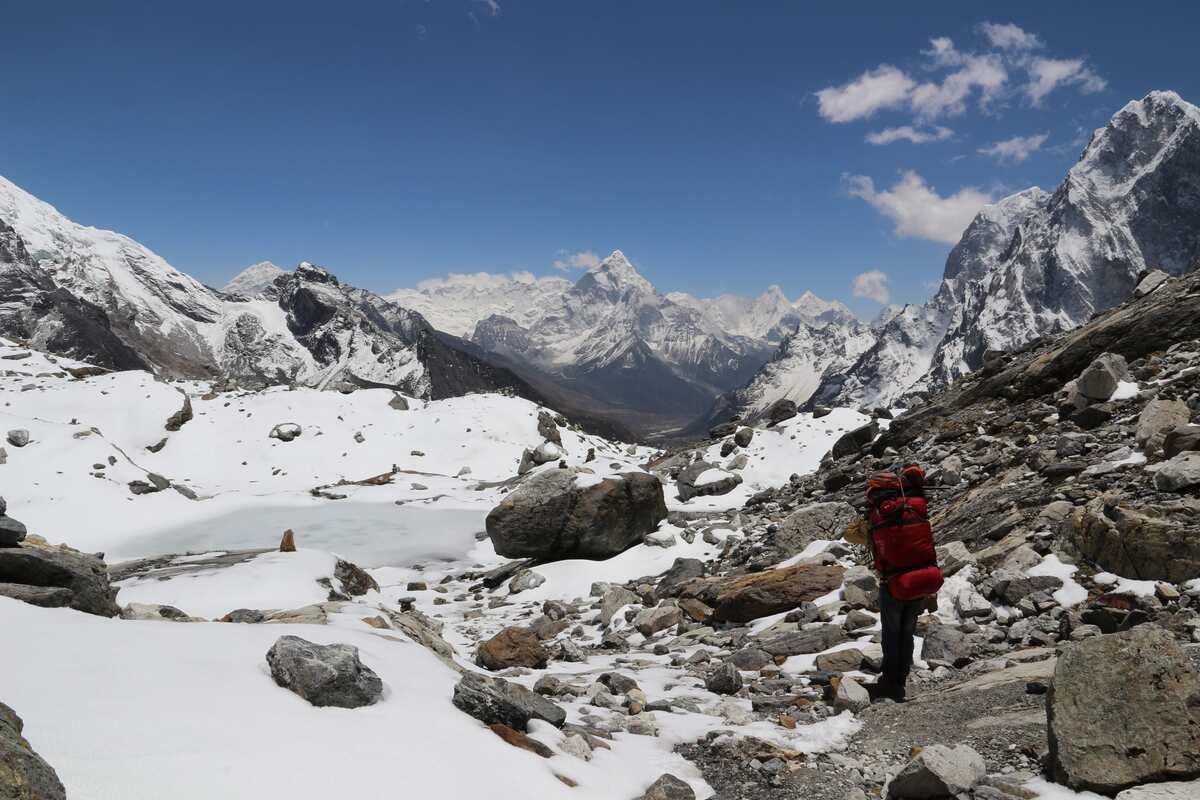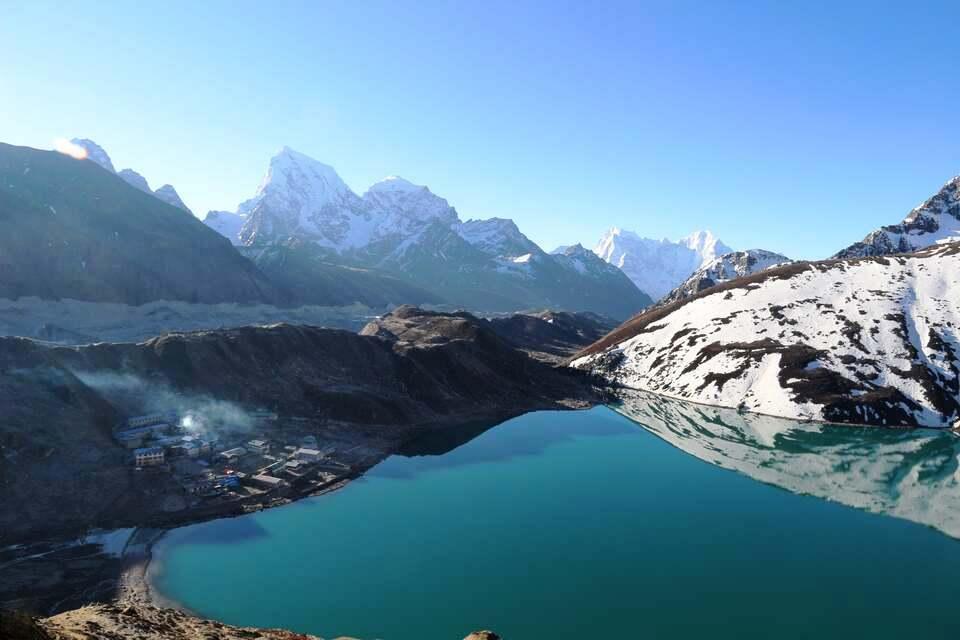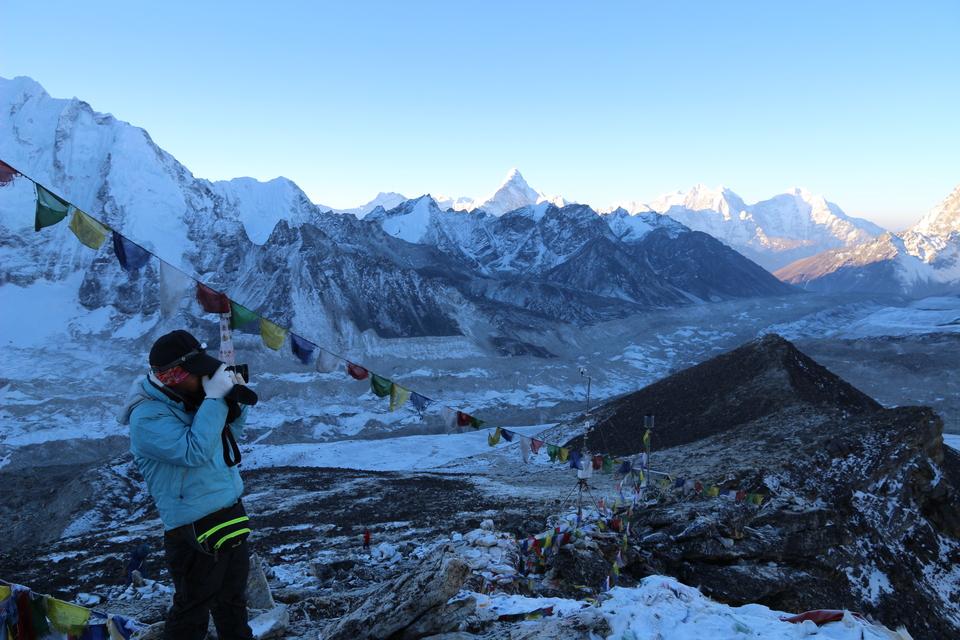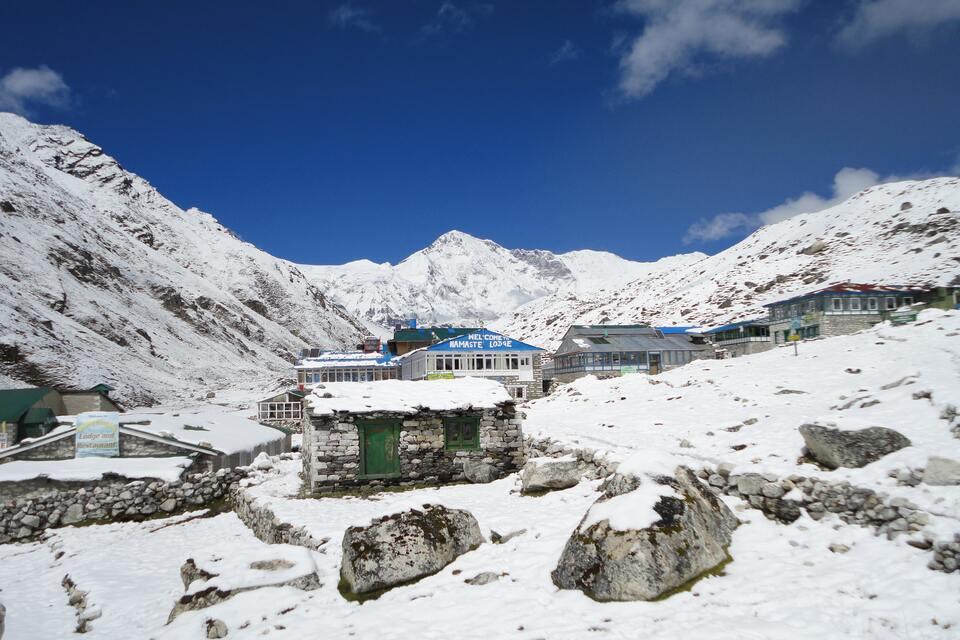Everest Three Passes Trek
Trip at a Glance
Everest Three Passes Trek is a challenging adventure in the Everest region. The trek is the appropriate choice for those seeking a high-altitude trek in the Himalayas. It consists of crossing over three high mountain passes in the Everest region, namely Kongma La Pass (5,535/18,159ft), Cho La Pass (5350 m/17,552 ft), and Renjo La Pass (5,340 m/17,520 ft), including attending the Everest Base Camp.
Lukla, the gateway to the Everest region, is where the trek starts after a scenic flight from Kathmandu. The Everest three-pass trek itinerary then follows an amusing route, passing over traditional Sherpa villages, lush valleys, and dense forests. Along the trek trail, you will have a nice opportunity to interact with friendly Sherpa people, learn about their culture.
Trekking the three passes in the Everest region is a great adventure and accomplishment in itself. Trekkers have to pass the three ultimate passes in Khumbu, which presents an immense challenge and adventure. These passes offer some of the most stunning views of the Himalayan peaks not seen elsewhere in the Everest region. They include Everest, Lhotse, Nuptse, and other towering peaks. Tackling all three passes requires a good level of physical fitness, enough acclimatization, and better pre-planning before the trek starts.
If you are looking for a once-in-a-lifetime experience and thinking of an inevitable trekking experience in the high Himalayas, then the Everest Three Passes trek is the undeniable choice for your adventurous spirit.
Everest Three Pass Trek Highlights
- An exciting & challenging adventure for adventure-seeking trekkers.
- Enjoy a quick scenic flight between Kathmandu and Lukla.
- Explore the lifestyle of the Sherpas & explore Namche Bazaar, the gateway to Everest..
- Marvel at the breathtaking views of Everest, Cho Oyu, Gyachung Kang, Lhotse & more towering mountains.
- Embark on a hike to Kala Patthar (5550 m), where you can witness the incredible Everest (8848m) up close!.
- Cross the grand three mountain passes, Renjo La Pass (5360m), Cho La Pass (5420m) & Kongma La Pass (5535m)
- Discover unparalleled joy in the peaceful surroundings & sparkling waters of Gokyo Lake at 4790m.
- Embark on an enchanting journey to the renowned Tengboche Monastery.
- Observe a variety of plant and animal species in Sagarmatha National Park.
What are the three passes in the Everest region?
The three passes in the Everest region are the three high-altitude passes connecting regions like Everest Base Camp, Gokyo Lakes, the Khumbu Valley and the Imja Tse Valley. Trekking these three passes is a challenging and amazing adventure that offers spectacular views and an absolute trekking experience. It’s a demanding circuit trekking trail that goes around the Khumbu region, offering a more extensive and challenging trek. Trekkers will witness the beauty of the Gokyo Lakes, the Everest Base Camp trail, and remote valleys.
- Kongma La Pass (5,535m/18,159ft)
Kongma La Pass is considered one of the more challenging passes that connect the Khumbu Valley with the Imja Tse Valley. The pass is a crucial link in between these two valleys which are otherwise separated by rugged terrain. With a steep ascent and descent, often over rocky and icy terrain, Kongma La is often considered the most challenging of the three passes and is also the highest.
If fresh snow or ice is present, the pass can be particularly difficult. Proper gear like crampons is a must, especially during the colder months. Atop Kongma La Pass, one can witness spectacular views of the surrounding peaks, including Makalu, and the vast glacial landscapes. It requires a good level of fitness to cross Kongma La.
- Cho La Pass (5,420m/17,782ft)
Cho La Pass is known for its rocky terrain and spectacular views which links the Gokyo Lakes region with the Khumbu Valley. It allows trekkers to combine the Gokyo Lakes trek with the Everest Base Camp trek. With it’s rocky terrain, the pass can be demanding to navigate. There’s a steep ascent and descent often over loose rocks. Another difficulty level of the pass is the glacier crossing which can be challenging. Chola offers an amazing panorama of the surrounding peaks that includes AmaDablam and Cholatse. Crossing the pass requires proper footwear and trekking poles.
- Renjo La Pass (5,360m/17,585ft)
Renjo La Pass connects the Gokyo Valley with the less-visited Thame Valley. Despite being regarded as the easiest of the three passes, Renjo La nevertheless requires a steep ascent and descent. Because of the altitude and potential for strong winds, the pass can be difficult. Renjo La has stunning views of the neighboring peaks, including as Makalu, Lhotse, and Everest, as well as the Gokyo Lakes. The pass offers some of the best views in the Everest region. Having the right clothes and equipment is crucial, particularly in the winter. The steep descent on the opposite side of the pass can be hard on the knees.
How difficult is the Everest Three Passes Trek?
The Everest Three Passes Trek is regarded as one of the most difficult treks in Nepal and the Everest region. All three crossings exceed 5,300 meters (17,388 feet), indicating that the trek is done at high elevations. This raises the risk of altitude sickness significantly. Different people's bodies react differently to various elevations, and even experienced hikers may suffer some effects.
The terrain is extremely diverse and challenging that including steep ascents and descents, rocky and uneven trails, glacier crossings, scree and loose rock sections. While crossing the passes, a great level of physical ability and careful foot placement are necessary. Trekkers should be prepared for long trekking hours each day, which typically last six to eight hours or longer.
In the Everest region, the weather is quite unpredictable. Trekkers can experience freezing temperatures, strong winds, snowfall. These circumstances may make the hike much more challenging and possibly risky. Crampons are necessary in some places, especially on the Cho La and Kongma La passes, especially in the winter or after snowfall.
This trek might not be suitable for beginners. Trekkers should be comfortable with difficult terrain and possess a good experience of high-altitude trekking. It is crucial to have a high level of leg strength and cardiovascular fitness. Before attempting the trek, trekkers should undergo intense training. There should be enough extra days for acclimatization and trekkers should be aware of the symptoms of altitude sickness.
Best Time for Everest Three Passes Trek
The best seasons for trekking the three passes in the Everest region are spring and fall. Rhododendrons blossom and the days get warmer in the spring. There are clear skies and good visibility in the fall.
- Everest Three Passes Trek during Spring (March to May)
Most people agree that this is the best season for Everest Three Passes Trek. There is more visibility due to the clearer skies and warmer days. Although it is colder at higher elevations, temperatures at lower elevations are pleasant. During this season, rhododendrons blossom, enhancing the scenery with vibrant colors.
Trekkers will witness an unobstructed panorama of the mountains. The weather will be relatively stable with longer hours of daylight. During these months, the temperature ranges between 18°C and -12°C. There is also little chance of snowfall or rain during these seasons. Expect to see more trekkers on the trails during this busy and popular time of year.
- Everest Three Passes Trek during Autumn (September to November)
In autumn, the air is clear and clean after the rainy season, providing good visibility. The weather is steady and the days are sunny and dry. Particularly at higher elevations, temperatures are cooler than in the spring. The advantages of trekking Everest Three Passes Trek in autumn are excellent visibility and stable weather conditions with less chance of rain.
But still be ready for extremely cold weather at any time of year, particularly at night and at higher elevations. At any time of year, the passes themselves can be quite cold and windy. Snowfall is a possibility even in the best seasons, especially at higher elevations.
Particularly on the passes, be ready for ice conditions. These months typically have temperatures between 20°C and -3°C. There will likely be more trekkers during this popular time.
- Everest Three Passes Trek during Monsoon (June to August)
Avoiding trekking during the monsoon season is advisable since the routes become slippery and risky due to excessive rainfall. Views of the mountains are also obscured by clouds. Temperature in monsoon rang from 27°C to 5°C.
- Everest Three Passes Trek during Winter (December to February)
Winter trekking is really challenging because of the low temperatures and a lot of heavy snowfall. During this time, many teahouses are closed. With temperatures ranging from 15°C to -15°C, December and January are extremely cold winter months.
Although it is not the best time of year for the Everest three high passes, witnessing Khumbu's winter will be an unforgettable experience. However, doing so requires good preparation. You must pack very warm clothes and take extra caution due to the various risks that winter brings.
Itinerary
Day 01: Arrival in Kathmandu (1400m)
Day 02: Flight from Kathmandu to Lukla (2840m/40min) & trek to Phakding (2610/3-4hrs)
Day 03: Trek from Phakding to Namche Bazaar (3440m/5-6 hrs)
Day 04: Acclimatization day at Namche Bazaar & Hike to Hotel Everest View (3880m/3-4 hrs)
Day 05: Trek from Namche Bazaar to Tengboche (3860m/5-6 hrs )
Day 06: Trek from Tengboche to Dingboche (4410m/5-6 hrs)
Day 07: Rest Day In Dingboche (4410m)
Day 08: Trek from Dingboche to Chhukung (4,730/4-5 hrs)
Day 09: Trek from Chhukung to Lobuche via Kongma La Pass (5,535 m/8-9 hrs)
Day 10: Trek from Lobuche to Gorakshep (5140m) / Hike to to Everest Base Camp (5364 m) & back to Gorakshep (8-9 hrs)
Day 11: Hike from Gorak Shep to Kala Patthar (5550m) to Lobuche (4910m/8-9 hrs)
Day 12: Trek from Lobuche to Dzongla (4830/4-5 hrs)
Day 13: Trek from Dzongla to Gokyo (4750m) via Cho La Pass (5420m/8-9 hrs)
Day 14: Excursion day at Gokyo; ascent to the Gokyo Ri (5357m/3-4 hrs)
Day 15: Trek from Gokyo to Lunden via Renjo La Pass (5340m/7-8 hrs)
Day 16: Trek from Lunden to Thame (3800/4-5 hrs)
Day 17: Trek from Thame Namche Bazaar (3440m/4-5 hrs)
Day 18: Trek from Namche to Lukla (2,840/6-7 hrs)
Day 19: Flight from Lukla to Kathmandu (1400m/40min)
Day 20: Final departure
Arrive in Kathmandu and one of our representatives will receive you and transfer you to your hotel in Kathmandu. The rest of the time is free to explore the city where your hotel is located which is usually at Thamel – the popular tourist hub in Kathmandu where every needs and facilities for the tourist are located like hotels, pubs, restaurants, departmental stores, trek gear shops etc. Or you can simply rest at your hotel if you are jet lagged and get ready for an amazing Himalayan trek. Overnight at Hotel in Kathmandu.
Wake up early in the morning and drive to the domestic section of the airport in Kathmandu for a flight to Lukla. After checking the weather it’s flight from Kathmandu to Lukla at Tenzing Hillary Airport. You will have a packed breakfast from the hotel which can be eaten while waiting for the plane at Kathmandu airport.
After a 40-45-minute flight from Kathmandu, you will finally land at Lukla and then begin your trek to Phakding –a small village in the Khumbu region. Lukla is also the place where your porters will be waiting for you. The trail goes through a green path crossing several villages like Chauri Kharka and Ghat then finally reaches Phakding for an overnight stay. Overnight at Lodge in Phakding.
Note: Flights from Tribhuvan International Airport (TIA) in Kathmandu to Lukla and vice versa may be rerouted to Manthali during the peak trekking seasons of March, April, May, September, October, and November due to increased air traffic congestion. Manthali is a 5-hour drive from Kathmandu and we need to start at 12.30am for the Kathmandu/Manthali drive to catch the flight to Lukla from Manthali. During December, January, February, June, July, or August, it's a direct flight from Kathmandu to Lukla and vice versa.
After breakfast, the trek begins with the trail going through forests, traditional villages with ploughed fields, and yak pastures then reaches the entrance of Sagarmatha National Park from where Mt. Thamserku can be spotted.
After completing permit formalities and having lunch you will climb up to Namche Bazaar. Namche Bazaar is the gateway to the Everest region and the biggest Sherpa town in the Khumbu region where many hotels, luxury resorts, restaurants, pubs, trek shops etc. are located. You name it, they have it at Namche and if you forget to shop for any trekking gear in Kathmandu, Namche is the last point to do so but the price may differ. Overnight at Lodge in Namche Bazaar.
Today is the rest day at Namche Bazaar for acclimatization and to cope with the rising elevation. You can go for a side excursion to Hotel Everest View (3880m) which is considered the hotel located at the highest point on earth. From its balcony, you can have the first glimpse of Mt. Everest and other world’s highest peaks sipping tea/coffee. Then it’s back to your hotel in Namche Bazaar. In the evening, you can explore Namche, talk with the locals, and meet many other trekkers and mountaineers from around the world. Overnight at Lodge in Namche Bazaar.
Today’s trek involves many steep ascents and descents, and it’s also a good opportunity for nice photography. On the list are Stupas (Buddhist shrines), prayer flags, mani walls (walls with Buddhist prayers carved into them), and mountains, such as Ama Dablam, and Tengboche Monastery which all are worth a good picture.
The trail up to Tengboche from Lukla is a dusty switchback path but it is all worthwhile as you reach Tengboche which offers a spectacular panorama. Tengboche has the largest Buddhist monastery which is the largest and the most important monastery in Khumbu. Pay a visit to the monastery and with a small donation, you can light some butter lamps. Overnight at Lodge in Tengboche
The trail is quite challenging today but with a very scenic route. The trail follows the Imja Khola ‘River’ climbing up to Dingboche and passing along windswept fields (mainly potato). Dingboche is the highest Sherpa village in Khumbu. The view of AmaDablam is spectacular from Dingboche which arrived during lunch time. After lunch at Dingboche, the rest of the afternoon is free to explore watch the surrounding Himalayas or dig into your books. etc. Overnight at Lodge in Dingboche.
Trekkers and climbers on their way to Imja Tse, Ama Dablam, or Mount Everest frequently stop at Dingboche. The picturesque settlement features a variety of fields surrounded by stone walls that shield potatoes, barley, and buckwheat from grazing animals and the chilly wind. To acclimate, we spend a day at Dingboche. For fantastic views of Makalu, Lhotse, Chalotse, Tawache, Ama Dablam, and other mountains, we climb for a full day to Nagarjun Hill.
Today, the trail combines some descents and ascents. We leave Dingboche after breakfast and travel to Chhukung to enjoy lunch. You can stroll on the paths gradually and steadily because Chhukung is our final stop for the day.
Numerous historic farms and fences made of local stone can be seen along the walk. and proceed via the Imja Khola valley in Bibre, a region inhabited by yak herders. We arrive in Chhukung after a four to five hour hike, where we will have lunch and spend the night.
We will be climbing Kongma La Pass for approximately eight to nine hours today. For Kongma La pass, there are two routes: one returns to Bibre via the trail above the Niyang Khola and crosses the Nuptse Glacier moraines northwest of Chhukung.
We bring our own packed meals and water because there are no motels, stores, or tea houses in the area. Buddhist prayer flags of great beauty may be seen at the summit of Kongma La pass. We turn north to Lobuche after passing Khumbu Glacier.
Today is the day you will be attending Everest Base Camp, the foot of Mt. Everest. You will start first with 3 hours hike to the small village of Gorekshep passing over boulders and rough terrain.
Then hike to Everest Base Camp and upon arrival feel the majesty of the base camp, walk over the Khumbu Glacier from where Everest summiters start their journey to the top. Celebrate your achievement with your trek guide and other members at the base camp. From the base camp enjoy views of Khumbu Icefall, Khumbu Glacier, Nuptse, Pumori, Khumbutse, and a little bit of Everest. Afterwards, back to Gorekshep for the overnight stay.
This will be one of the trek's hardest but most rewarding days. We spend the majority of this day ascending 5,555-meter Mount Kala Patthar. Superb views of Everest may be seen from Mt. Kala Patthar.
Following a brief stay at Kala Patthar, we descend in the direction of Lobuche. The Himalayas and the Rocky Mountains encircle this tiny community. The majority of the lodges are of the older, more traditional style, but more modern lodges have emerged recently, some of which offer internet access and oxygen services.
We begin our descent from Lobuche, and after a few hours, the trail splits in two, with us choosing the right path to Dzongla. In the distance, stupas and tombstones are seen. Following that, we hike higher and can see Chola Tsho Lake in the distance. We trek on, first going over a bridge over Chola Khola and then arriving at Dzongla.
In order to cross Cho La Pass before midday today and reevaluate the climb in the event of inclement weather, we must begin our trek before 4-5 am today. Due to the high altitude and steeply unstable rock, the trip may be a little challenging today.
Even in favorable weather conditions, rock falls and snow can pose a risk when traversing Cho La Pass. You will thus be able to enjoy the breathtaking panorama from the top of Cho La Pass before we descend to Gokyo (4,800 m).
The longest glacier in Nepal, the Ngozumpa, must be crossed, together with the Pangka and Khara glaciers. We have a stunning view of Cho-Oyu Mountain and Kantaga. The Gokyo Lake is the third of a sequence of six lakes.
We have a strenuous trek early in the morning to the 5,483-meter summit of Gokyo Ri. For those who take on this journey, there are plenty of incentives. You can take in breathtaking views of the enormous Ngozumpa glacier, the huge Gokyo valley, and the entire Khumbu Himalayas, which includes the towering Everest, Lhotse, Nuptse, Makalu, Cho-Oyu, and Gychung Kang.
We set out on our walk this morning. Today's hike is lengthy, although it follows the standard route. A breathtaking view of Mount Everest is available from the top of Renjo Pass. Then we make our way down to Lunden, which is our ultimate destination for today.
We have breakfast and then begin our trip. The trail will primarily drop to Thame today.
The snow peaks that we can see while hiking are breathtaking. The Thame Monastery is a charming monastery situated amidst the numerous residences of monks and laypeople, approximately 150 meters above the town.
It is perched atop a hill with a view of the valley below. This is the location of the Mani Rimdu festival, which takes place every year around the middle of May.
With one of the oldest monasteries in the area, Thame is a typical Sherpa settlement that has managed to avoid the hordes of people climbing Everest. Notably, Apa Sherpa, who has reached the peak of Everest 21 times, was born and raised in this village!
The path itself winds in and out of the canyon's woodland, providing serene vistas of the surrounding mountains. We carry on with our journey today, walking from Thame down the hill.
Namche Bazar will be the final destination for the day's journey, and the walk will be brief and easy.
Finally we return back to Lukla where the trek began, which will seem like ages ago. It will give you time to reflect on the trek also giving you time to explore the town.
Ambulating on the lap of super mountains for almost two weeks and cuddling some sweet and sour memories, we take a flight back to Kathmandu from Lukla. Upon arrival at KTM, check in to the hotel for an overnight stay. You can refresh and relax to do away with the fatigue.
You feel like Nepal is your second home, don’t you? Well, time to get back to your first home now. You came in as a visitor, but you are going back as a friend. Our representative will escort you to the airport 3 hours prior to the flight schedule. Goodbyes are not forever, goodbyes are not the end, they simply mean we will miss you, till we meet again! Have a safe flight back home and we look forward to being your adventure companion in Nepal again
What is included?
- Airport pick-up and drop services.
- Hotel accommodations in Kathmandu with breakfast.
- Kathmandu/Lukla/Kathmandu round airfare.
- All trekking accommodations with Breakfast/Lunch/Dinner at local lodges.
- Four seasonal sleeping bags and duffel bags (to be returned after trip completion).
- A comprehensive medical kit (will be carried by the trekking guide).
- Experienced Government licensed English Speaking Guide & Porter (1 porter for two people) including their food, accommodation, salary & insurance.
- Permits for Everest National Park and TIMS (Trekkers' Information Management System)
- Farewell dinner with a live Nepalese cultural program.
- All government and local taxes.
What is not included?
- International airfares.
- Nepal entry visa fee – Visa can be obtained upon your arrival at the Tribhuwan International Airport in Kathmandu. (USD30 for 15 days)
- Lunch & dinner in Kathmandu.
- Personal travel insurance.
- Emergency rescue evacuation (to be covered by the client's travel insurance).
- Excess baggage charges (luggage allowance for domestic airlines in Nepal is 15 kgs.).
- Other expenses of a personal nature (phone calls, laundry, battery recharge, extra porters, bottle or boiled water, hot shower etc.)
- Bar bills, alcoholic drinks & beverages.
- Tips to guide & porters (Tipping is expected).
Route Map
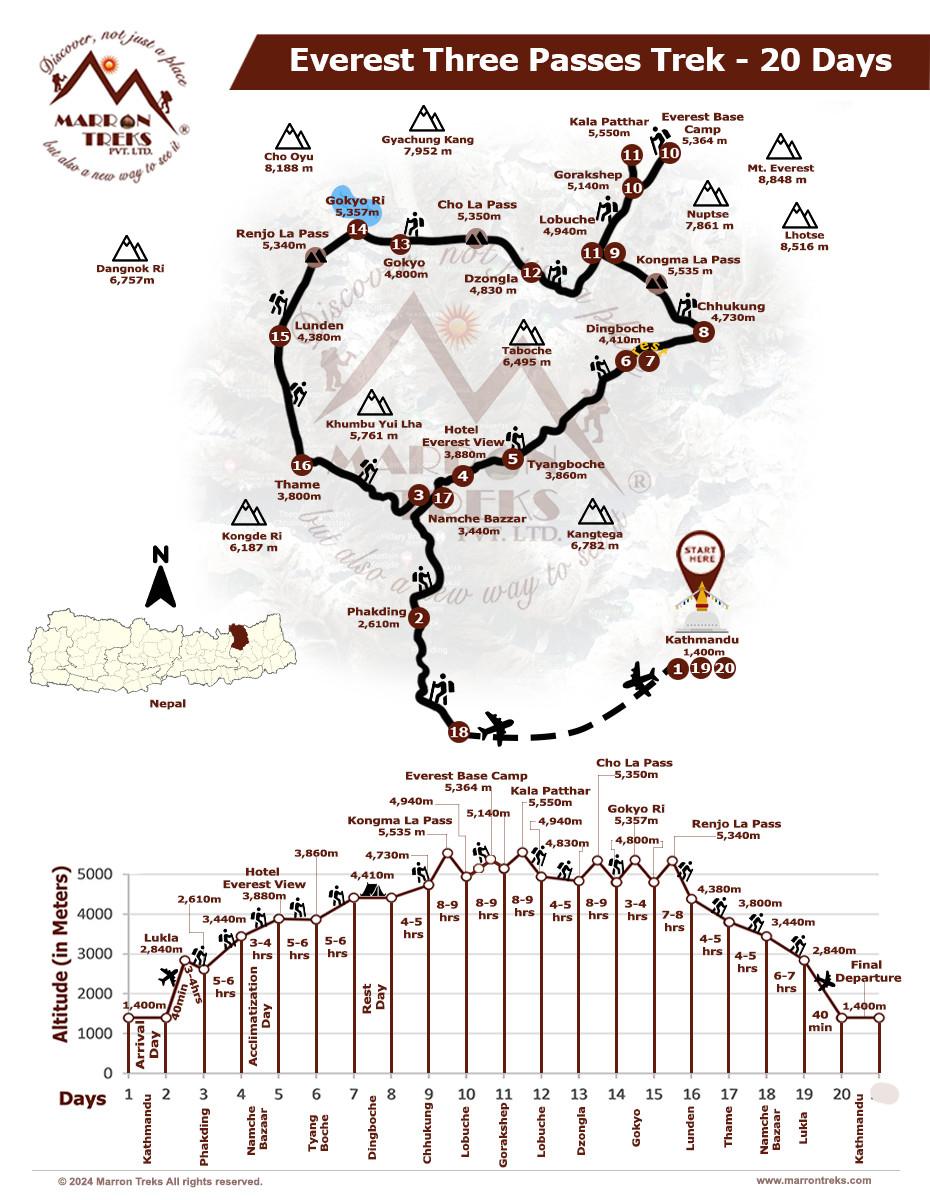
Trip Info
Accommodation
While you are in Kathmandu, we opt to accommodate you in 4- or 5-star hotels like Hotel Royal Singhi (4-star), Hotel Manaslu (4-star), Radisson (5-star), Yak & Yeti (5-star), or similar. During the trek, you will be accommodated in a local mountain lodge, better known as Tea House. These lodges and teahouses provide good services and are equipped with basic amenities. We will endeavor to provide you with the best accommodation available along the route so that you get a good night’s rest in a hygienic milieu.
Meals
We never compromise the quality of food or the health of the trekkers as well as the crew members. Generally, we opt for the fresh and nutritional local community food available. You could make your delicious pick from an array of traditional foods like Sweet potatoes, buckwheat barley, etc. This way, you could not only get a real sense of the local culture and life patterns but also contribute to promoting the locally available resources of organic food and beverages. Besides, a wide range of Continental, Chinese, Italian and Indian cuisines like Pizza, Spaghetti, French Fries, Soups, Breads, Masala curry, etc. are also available in the restaurants for your retreat.
Acclimatization
Altitude sickness is a serious risk while trekking in the Himalayas. It's important to acclimatize properly by spending a few days at lower altitudes before heading higher. By spending time at lower altitudes before pushing higher, your body has time to adjust. Our trekking packages have enough acclimatization days planned where you'll be spending a day or two at lower altitudes, allowing your body to adjust to the increasing altitude.
Electricity & drinking water
For an additional cost, you can use the electricity in all tea houses and lodges to recharge your batteries. The lodges have packaged mineral water for sale, or you can fill your bottle with boiling water. To make water drinkable, you can use water purification tablets too. But, due to hygienic issues, you should avoid drinking water from taps, rivers, or wells in trekking areas.
Communication
At lodges, restaurants, and hotels, Wi-Fi is available for an additional fee in the most popular trek regions, like Everest, and Annapurna. However, at high elevations, phone calls are the only means of connection. Our office in Kathmandu is in constant communication with your trek guide. In Kathmandu, you can purchase a local sim card for communication purposes. At high elevations, the mobile signal might not be as strong, though.
Luggage
Our porters are paired with one trekker for every two hikers, and one porter can safely carry 30 kg maximum weight. Therefore, we advise you to fill your duffle bag not more than 15 kg with your belongings. You may carry a small backpack with your valuables and informational documents. The things you are not taking along on the trek can be stored in a hotel in Kathmandu free of cost.
Typical Trek Day
Mostly your trek day starts with breakfast at 7-8 am, followed by a 3-4 hour morning trek. Lunch break is around an hour, then you continue trekking to your destination for the day. After reaching the teahouse lodge, you can relax, explore nearby areas, and enjoy dinner at 6-7 pm. Evenings involve socializing, a trek briefing, and leisure activities before bed.
Travel Insurance
It is advised that you arrange your travel insurance before leaving your homeland. The main thing is to make sure that your insurance covers you for both- medical and evacuation costs. Having travel insurance with you makes your trip secure and hassle-free.
Our Guides
Guides play a significant role during the trek. They are the ones who literally decipher the trekking codes for you so that you can actually connect with nature, culture and people along the way. We have helpful and dedicated trekking guides who are very well-versed in the culture, life patterns and every single detail pertaining to the trek region you are traveling in. Thus, in the company of our professional Sherpa guides, your trek becomes not only entertaining but also equally informative.
Porter and Staff Care
When it comes to high-altitude trekking, porters and staff members make up a pivot. Marron Treks ensures that all the porters and staff members going to high altitudes are provided with adequate clothing and equipment. All our field staff are covered by insurance.
